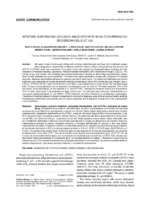Please use this identifier to cite or link to this item:
http://sgc.anlis.gob.ar/handle/123456789/101| Title: | Intestinal bleeding and occlusion associated with shiga toxin-producing escherichia coli O127:H21 | Other Titles: | Hemorragia y oclusión intestinal asociadas a escherichia coli O127:H21 productor de toxina shiga | Authors: | Rivas, Marta Miliwebsky, Elizabeth Balbi, Laura García, Beatriz Leardini, Nelida Tous, Mónica Chillemi, Germán Baschkier, Ariela Strugo, Liliana |
Keywords: | Escherichia coli;Toxina Shiga | Issue Date: | 2000 | Description: | We report a case of a nine-year old boy with vomiting, abdominal pain and fever, who underwent surgery with a diagnosis of appendicitis in Mendoza and from whom a Shiga toxin-producing Escherichia coli (STEC) O127:H21 strain was recovered. Forty-eight hours after surgery he presented bilious vomiting and two episodes of intestinal bleeding. Laboratory findings included: hematocrit, 35%; blood urea nitrogen, 0.22 g/L. The urinary output was normal. The following day physical examination showed an alert mildly hydrated child, without fever but with distended and painful abdomen. The patient was again submitted to surgery with a diagnosis of intestinal occlusion. Bleeding and multiple adhesions in jejunum and ileum were found. The patient still had tense and painful abdomen and presented two bowel movements with blood; hematocrit fell to 29% and blood urea nitrogen rose to 0.32 g/L. STEC O127:H21 eae(-)/Stx2/Stx2vh-b(+)/E-Hly(+) was isolated from a stool sample. He was discharged after 10 days of hospitalization and no long-term complications such as HUS or TTP were observed. This is the first report, to our knowledge, on the isolation of E. coli O127:H21, carrying the virulence factors that characterize STEC strains, associated to an enterohemorrhagic colitis case. This serotype was previously characterized as a non-classic enteropathogenic E. coli (EPEC). STEC infections can mimic infectious or noninfectious pathologies. Therefore an important aspect of clinical management is making the diagnosis using different criteria thereby avoiding misdiagnoses which have occasionally led to invasive diagnostic and therapeutic procedures or the inappropriate use of antibiotics. Se presenta el caso de un niño de 9 años, eutrófico, perteneciente a una familia de bajo nivel socioeconómico en Mendoza, que ingresó al hospital con vómitos, fiebre y dolor abdominal y al cual se le practicó apendectomía, aislándose Escherichia coli O127:H21, productor de toxina Shiga (STEC) en el coprocultivo. A las 48 horas post-cirugía, el paciente presentó vómitos biliosos y dos episodios de hemorragia intestinal. El hematocrito fue de 35% y la uremia de 0.22 g/L. La diuresis fue normal. Al día siguiente estaba afebril, alerta, hidratado, pero con el abdomen distendido y doloroso. Fue enviado nuevamente a cirugía con diagnóstico de oclusión intestinal, observándose durante la misma, sangrado intestinal y múltiples adherencias en yeyuno e íleo, que fueron manualmente removidas. El paciente continuó con distensión abdominal y presentó dos deposiciones sanguinolentas, el hematocrito disminuyó a 29% y la urea en sangre se elevó a 0.32 g/L. STEC O127:H21 eae(-)/Stx2/Stx2vh-b(+)/ E-Hly(+) fue aislado de la materia fecal. El niño fue dado de alta después de 10 días de hospitalización sin presentar complicaciones como SUH o PTT. Esta es la primera comunicación sobre el aislamiento de E. coli O127:H21 de un caso de enterocolitis hemorrágica, con los factores de virulencia que caracterizan a STEC. Este serotipo era reconocido como perteneciente a la categoría de E. coli enteropatógeno no clásico. Teniendo en cuenta que las infecciones por STEC pueden mimetizar otras patologías infecciosas o no infecciosas, es importante utilizar distintos criterios diagnósticos, para evitar prácticas médicas o tratamientos innecesarios. Fil: Rivas, Marta. ANLIS Dr.C.G.Malbrán, Instituto Nacional de Enfermedades Infecciosas; Argentina. Fil: Miliwebsky, Elizabeth. ANLIS Dr.C.G.Malbrán, Instituto Nacional de Enfermedades Infecciosas; Argentina. Fil: Balbi, Laura. Hospital Pediátrico Dr. Humberto Notti; Argentina. Fil: García, Beatriz. Hospital Pediátrico Dr. Humberto Notti; Argentina. Fil: Leardini, Nelida. ANLIS Dr.C.G.Malbrán. Instituto Nacional de Microbiología; Argentina. Fil: Tous, Monica. ANLIS Dr.C.G.Malbrán. Instituto Nacional de Microbiología; Argentina. Fil: Chillemi, German. ANLIS Dr.C.G.Malbrán, Instituto Nacional de Enfermedades Infecciosas; Argentina. Fil: Baschkier, Ariela. ANLIS Dr.C.G.Malbrán, Instituto Nacional de Enfermedades Infecciosas; Argentina. Fil: Strugo, Liliana. Hospital Pediátrico Dr. Humberto Notti; Argentina. |
URI: | http://sgc.anlis.gob.ar/handle/123456789/101 http://www.medicinabuenosaires.com/revistas/vol60-00/2/v60_n2_249_252.pdf |
ISSN: | 0025-7680 | Rights: | info:eu-repo/semantics/openAccess |
| Appears in Collections: | snrd Publicaciones INEI |
Files in This Item:
| File | Description | Size | Format | |
|---|---|---|---|---|
| Medicina(Buenos Aires),2000,60(2),249–252.pdf | 108.5 kB | Adobe PDF |  View/Open |
Page view(s)
120
checked on Oct 8, 2025
Download(s)
32
checked on Oct 8, 2025
Google ScholarTM
Check
Items in DSpace are protected by copyright, with all rights reserved, unless otherwise indicated.

